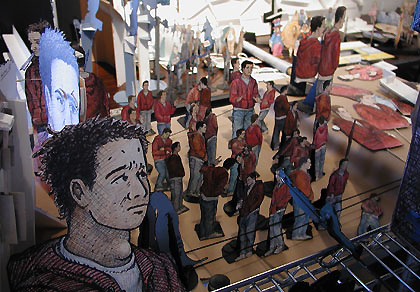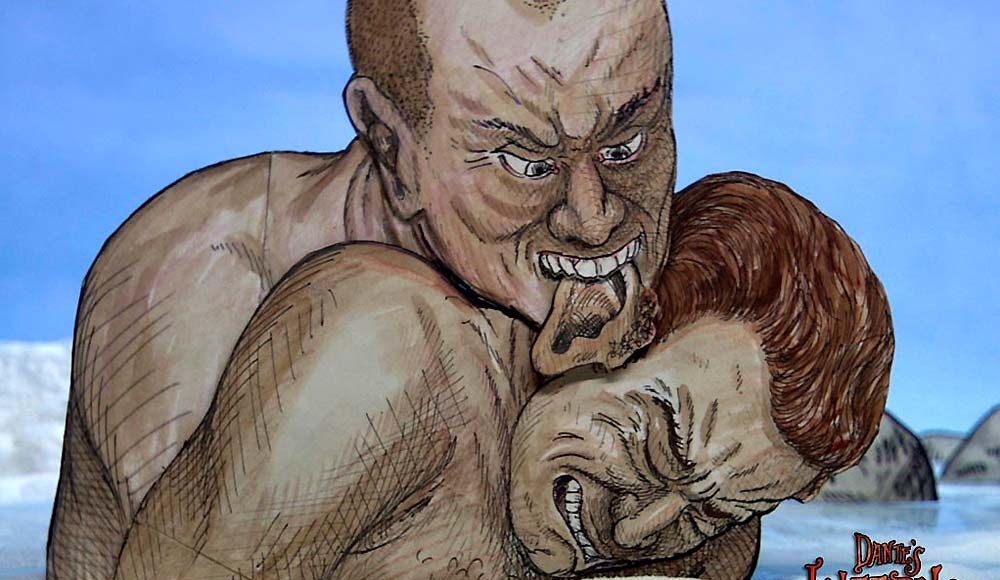Ernest Kearney — I love it when I’m describing a film to someone and I see that pallid perturbed look of perplexity slowly pervade their faces as they begin to suspect that I’m just screwing with them, that I’m concocting a ludicrous, “movie” simply to see if they’re gullible enough to fall for it.
“Oh, man, kid you not,” I enthuse enthusiastically, “the most faithful adaptation of Dante Alighieri’s Inferno ever.
Well, yeah, took it outta Hell and put it in Los Angeles, but six of one, half a dozen of the other.
And, yeah… they modernized it. So instead of Brunetto Latini and Guido da Montefeltro suffering in the “abode of the damned” it’s Robert Moses, Strom Thurmond and Jim Jones.
But Virgil still leads him down into Hell, and it’s got a three-headed Cerberus, the centaurs, false prophets with their heads twisted around 180˚, and it’s got a great musical number…!
Who’s in it?
That guy from the talking pig movie (James Cromwell).
And Beakman (Paul Zaloom)! He’s the head puppeteer too.
What? I didn’t mention the whole thing’s done with two-inch-tall cardboard puppets…? My bad.
Yeah, I get looks.
There have been a number of efforts to film Dante’s 14th century epic poem The Divine Comedy; none very successfully. The attempts have been limited to just Part One: The Inferno. That’s because the subsequent books, the Purgatorio and the Paradiso are…well, boring.
Let’s face it, Hell is a rough act to follow. Also, back in the day of tighter censorship, the Inferno allowed filmmakers the opportunity to expose a good bit of the suffering sinners’ naked flesh while Satan’s imps indulged in some S&M for the sake of their salvation.
But as far as I’m concerned, the gold medal goes to Sean Meredith’s Dante’s Inferno (2007) based on the graphic novel by Sandow Birk. This was the second collaboration between the director and the artist, the first being an intriguing little mockumentary entitled In Smog and Thunder (*see below), which like Dante’s Inferno, was based on Birk’s rather twisted art.
A graduate of Los Angeles’ Otis Art Institute of Parsons School of Design, Birk shows an inclination towards manifesting the timeless quality of art through the coupling of concepts which fracture rather than fuse, with the dissonance arising from the natural incoherence of modernity with antiquities.
This was apparent in his 2000 installation at the Laguna Art Museum. “In Smog and Thunder: Historical Works from the Great War of the Californias,” was an ambitious undertaking consisting of over 200 paintings, drawings, maps and models accompanied by pseudo-historical commentary chronicling the epic war between Los Angeles and San Francisco for control of California.
With titles such as “Bomb the Bay!”, “The Battle of Los Angeles” and “Remember the Haight,” the works invoked a variety of historical styles:
- the “atrocity propaganda” cranked out by the U.S. government’s Committee on Public Information during World War I,
- Goya’s The Disasters of War etchings,
as well as
- Winslow Homer’s Civil War illustrations and
- the paintings of Ole Peter Hansen Balling.
In 2003, Sean Meredith directed *In Smog and Thunder, a faux documentary based on the “historical” conflict presented by Birk’s art, parodying Ken Burns’ PBS Civil War series, while examining the rivalry between the two West Coast cities.
The actor Paul Zaloom, best known for Beakman’s World, in which he portrayed the eccentric scientist, provided the voiceover for the satirica,l pseudo-historical epic which also featured the PBS late great Huell Howser.
In 2005 Birk collaborated with writer Marcus Sanders to produce a trio of graphic novels of Dante’s The Inferno, The Purgatorio and The Paradiso rendered in the modern settings of Los Angeles, San Francisco (with a jaunt over to Tokyo) and New York (with a hasty swing by way of Mecca.)
The three graphic novels, with 135 illustrations by Birk created in the style of French artist Gustave Doré, treated modern America to the moral standards of Dante’s Christendom. America did not fare well.
When Meredith and Birk began discussing a filmed version of The Inferno, the decision was made to present it in the style of a Victorian “Toy Theatre” production.
Known in Germany as Kindertheater, or Children’s Theater and as Puppet Theater in Denmark or Dukketeater, Toy Theatres were hugely popular throughout all of Europe, but nowhere more so than the England of the Georgian era to the early Victorian period.

Made of sturdy cardboard, these elaborately designed replicas of actual London theatres came complete with curtains and scenery. Printed sheets were available with sets, props and characters from plays being performed on the London stages — such as a play of Robinson Crusoe based on Daniel Defoe’s novel, or the works of Shakespeare — all of which could be bought at every toy shop. The characters were then cut out and pasted onto thin cardboard which would be attached to small sticks or wires to allow them to be moved about the stage and the plays recreated for the whole family.
Sometimes the theatres offered sheets of shows running on their stage as a means of advertising. Hans Christian Andersen, Lewis Carroll and even Oscar Wilde had their works adapted for presentation on Toy Theatres.
As theater trends left behind the grand ornate staging for modern realism, the popularity of the Toy Theatre faded and while found, mainly, in museums today, Toy Theatres still pop up now and then. One instance is when the artist Edward Gorey, author and illustrator of such macabre works as The Beastly Baby and The Doubtful Guest, created a toy theatre based on his set designs for the 1977 Broadway revival of Dracula.
Zaloom came on as the head puppeteer and joined Birk and Meredith in adapting the script which required everything within film to be confined within the limits of a toy theatre production; so no animation, no stop motion, no computer-generated imagery, nothing but paper, glue, wire, string and a lot of imagination.
Eventually more than 500-character puppets were created, each designed by Visual Artist Elyse Pignolet, then hand drawn and colored by Birk on artist board, before being cut and mounted on blocks or wires.
The character of Dante alone required some 100 different paper puppets that stood barely two inches tall. Forty-six sets were built for the film which was to be shot on a wooden stage approximately the size of a pool table.
In this Inferno, Dante wears a hoodie and Hell is a seedier part of downtown L.A. Notable characters who figure prominently in the original work such as Minos, Caiaphas, Charon and Homer are still there, only now they’re joined by Spiro Agnew, L. Ron Hubbard, George Sanders, Marilyn Monroe, Nicolae Ceaușescu: The application of medieval sins to modern sinners allows for some pointed observations.
In the original, when Virgil and Dante must reach the lower levels of Hell they are flown down on the back of Geryon, the Monster of Fraud. Here they travel the downward trip aboard a Fox News helicopter.
In addition to Zaloom, the cast is a fascinating hodge-podge of talent and names. Voicing Dante is Dermot Mulroney who has countless credits including the unjustly neglected Living in Oblivion which I fully intend to get around to writing about one day. James Cromwell — Star Trek: First Contact and L.A. Confidential and who is alleged to be the tallest actor ever nominated for an Academy Award (6’5” for Babe) — is the poet Virgil.
Others making up the denizens of Hell include Tony Abatemarco one of L.A. theater’s most respected talents, Tony Hale familiar to fans of both Arrested Development and Veep, Matt Walsh also from Veep, Scott Adsit from 30 Rock, Dana Snyder who voices Master Shake in Aqua Teen Hunger Force, Kit Pongetti who appeared in another neglected gem Loudmouth Soup, and John Fleck who as an L.A. performance artist found himself, along with three other performers, targeted by Senator Jesse Helms and other conservative Republicans when they set about pressuring the National Endowment for the Arts (NEA) to yank their funding. The case of the “NEA 4” finally landed before the Supreme Court which told Jesse and his cultural lynch mob to take a hike.
After its release in 2007, Dante’s Inferno made the rounds of the festival with some success winning kudos at the Silver Lake Festival, the San Francisco Indie Fest and the Boston Underground Film Festival.
For me Dante’s Inferno works on every level; It is a truthful rendering of a 700-year-old poem, reworked for modern sensibilities. It remains nevertheless medieval in spirit and it succeeds in this most secular age to remind us of the sinfulness that exists in the world around us.
It is a film on art made into an artful film.
It is a fully realized, unique work with a surfeit of craftsmanship, creativity and imagination, which in this day and age makes Dante’s Inferno heaven sent.
* * *
Like us on Facebook
Follow us on Twitter @theTvolution
Stay Updated: Find our Subscription Box on the Left Rail
Contact Us: TheTvolution@gmail.com
We Thank You for Supporting Artfully Independent Voices
The Tvolution





